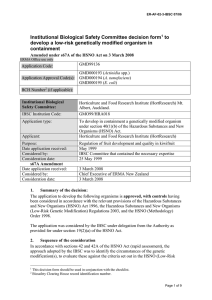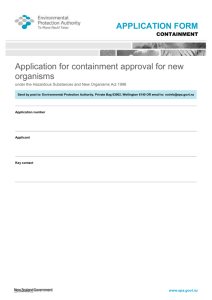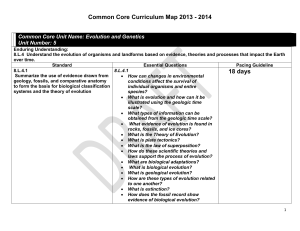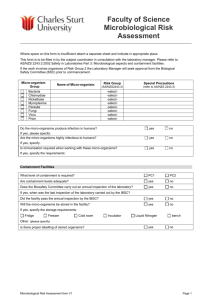Institutional Biological Safety Committee Decision Form to Develop
advertisement
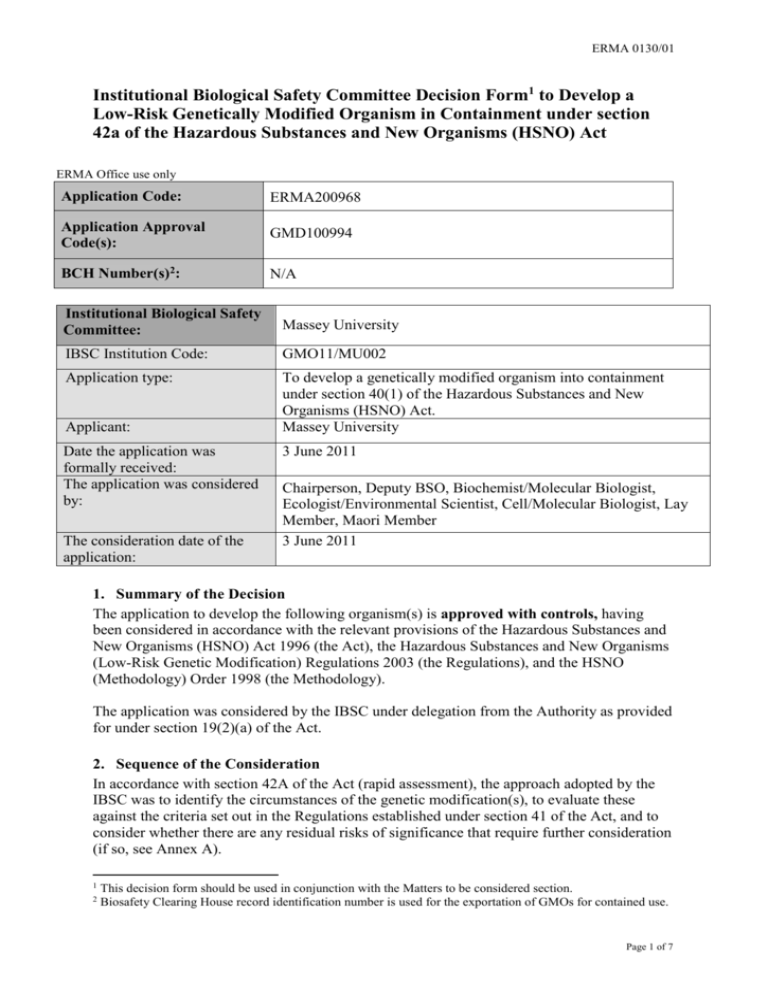
ERMA 0130/01 Institutional Biological Safety Committee Decision Form1 to Develop a Low-Risk Genetically Modified Organism in Containment under section 42a of the Hazardous Substances and New Organisms (HSNO) Act ERMA Office use only Application Code: ERMA200968 Application Approval Code(s): GMD100994 BCH Number(s)2: N/A Institutional Biological Safety Committee: Massey University IBSC Institution Code: GMO11/MU002 Application type: To develop a genetically modified organism into containment under section 40(1) of the Hazardous Substances and New Organisms (HSNO) Act. Massey University Applicant: Date the application was formally received: The application was considered by: The consideration date of the application: 3 June 2011 Chairperson, Deputy BSO, Biochemist/Molecular Biologist, Ecologist/Environmental Scientist, Cell/Molecular Biologist, Lay Member, Maori Member 3 June 2011 1. Summary of the Decision The application to develop the following organism(s) is approved with controls, having been considered in accordance with the relevant provisions of the Hazardous Substances and New Organisms (HSNO) Act 1996 (the Act), the Hazardous Substances and New Organisms (Low-Risk Genetic Modification) Regulations 2003 (the Regulations), and the HSNO (Methodology) Order 1998 (the Methodology). The application was considered by the IBSC under delegation from the Authority as provided for under section 19(2)(a) of the Act. 2. Sequence of the Consideration In accordance with section 42A of the Act (rapid assessment), the approach adopted by the IBSC was to identify the circumstances of the genetic modification(s), to evaluate these against the criteria set out in the Regulations established under section 41 of the Act, and to consider whether there are any residual risks of significance that require further consideration (if so, see Annex A). 1 2 This decision form should be used in conjunction with the Matters to be considered section. Biosafety Clearing House record identification number is used for the exportation of GMOs for contained use. Page 1 of 7 ERMA 0130/01 3. Decision 3.1. Purpose of the approval is: To develop strains of Dothistroma septosporum that will enable detailed understanding of how the fungus interacts with its plant host and, ultimately, to develop new methods to control Dothistroma needle blight disease. 3.2. The genetically modified organism(s) approved for development are: Name of the host organism (including taxonomic authority): Dothistroma septosporum (G. Dorog.) M. Morelet 1968 (as ‘septospora’) Specify the category of host organism eg, Category 1 or 23 Category 2 What the organism is modified with: Non-conjugative vectors containing standard selectable markers and reporter genes, well-defined coding sequences or regulatory sequences from D. septosproum and other ascomycete fungi. DNA sequences from native biota will be excluded, as will genes that increase the pathogenicity, virulence or infectivity of the host or its ability to escape containment. Category B Please specify vector and source and function of donor DNA Please specify the category of genetic modification eg, Category A or B3 Containment level e.g. PC1/PC24 PC2 Approved/Declined Approved 3.3 Controls In considering all the matters to be addressed, detailed in the Third Schedule Part I “Containment Controls for Importing, Developing or Field Testing of Genetically Modified Organisms” of the Act, the organisms and any containment facility they are contained in are subject to approval which is subject to the following controls: 1. Requirements to meet the Standards 1.1. The approved organism must be developed and held within a containment facility which complies with these controls. 1.2. The containment facility must be operated in accordance with the: 3 According to the Regulations. As in the Australian/New Zealand Standard 2243.3:2002 Safety in Laboratories: Microbiological aspects and containment facilities. 4 Page 2 of 7 ERMA 0130/01 o MAF/ERMA New Zealand Standard Facilities for Micro-organisms and Cell Cultures: 2007a5 o MAF/ERMA New Zealand Standard Containment Facilities for Plants: 2007 o The Australian/New Zealand Standard 2243.3:2002 Safety in laboratories: Microbiological aspects and containment facilities at Physical Containment Level 2 (PC2). 2. Controls additional to the requirements of the Standards 2.1. If a breach of containment6 occurs the approval holder must ensure that the MAF Inspector responsible for supervision of the facility has received notification of the breach within 24 hours. 2.2. Any genes derived from related fungi which are capable of causing disease should be characterised to the extent that their function is anticipated to only restore Dothistroma septosporum to its normal level of virulence (and not to increase it).7 Original signature (details typed in) Signed: ……………………………………….…………… (on behalf of the institution) Name: Professor Michael McManus Position: Chairperson, Massey University IBSC Date ………………......... 5 Any reference to this standard in these controls refers to any subsequent version approved or endorsed by ERMA New Zealand. 6 Breach of containment includes; escape of organism (s), unauthorised entry to facility, and/or structural integrity of the facility compromised. 7 The reasons for imposing additional controls must be justified in point 7.7 or 8.2 of the “Matters to be considered” section. The reasons for a site-specific decision must be justified in point 8.4 of the “Matters to be considered” section. Page 3 of 7 ERMA 0130/01 Matters to be considered Sections referenced in the text below indicate sections of the Hazardous Substances and New Organisms Act 1996 Clauses referenced in the text below indicate clauses of the Hazardous Substances and New Organisms (Methodology) Order 1998 Yes/No/ N/A 1 Legislative criteria for the application 1.1 The application was lodged pursuant to section 40(1) of the Act. Yes 1.2 The application was considered in accordance with section 42A and matters relevant to the purpose of the Act. Consideration of the application Yes Does the IBSC hold delegated authority as provided under section 19(2)(a) of the Act? Yes 2 2.1 2.2 2.3 2.4 2.5 If NO, the consideration cannot proceed. Has the quorum for the Decision-making Committee (ie, the members of the IBSC that will consider this application) been reached? If NO, the consideration cannot proceed. Does the Decision-making Committee have the appropriate expertise? If NO, the consideration cannot proceed. Does any member of the Decision-making Committee have a conflict of interest? If YES, the consideration cannot proceed until mitigated (eg, the member steps out of the room). (This should be noted in minutes.) Does the committee consider that there is sufficient information for the formal receipt of the application using the acceptance checklist? Yes Yes No Yes 2.6 If NO, the application cannot be considered. Please return to the applicant for further information. Is the purpose provided for under section 39 of the Act? Yes 2.7 Was any expert advice sought (clause 17 of the Methodology)? No 2.8 If YES – What is the name of the expert(s) and the nature of the advice sought? Was the applicant informed (clause 18 of the Methodology)? Is the consideration of this application within 10 working days of the formal receipt of the application? Yes Page 4 of 7 ERMA 0130/01 3 Assessment against the criteria for low risk genetic modifications 3.1 Is the IBSC satisfied that each of the genetically modified organisms described in the application meets the criteria for a low-risk genetic modification specified in the criteria made under section 41 of the Act, being the Regulations? 4 4.1 5 5.1 5.2 6 6.1 7 7.1 Yes If NO, give details. Applications involving native flora and fauna Does the application involve native or valued introduced flora and/or fauna as host organisms or as a source of genetic material? No If “YES”, please clearly record below the evidence that appropriate Māori consultation has occurred with local iwi regarding this approval (i.e. who was consulted, their status and the results of the consultation). Applications involving human genetic material or human cells Does the application involve the use of any genetic material or cells obtained directly from human beings? If YES, has approval from a Human Ethics Committee been obtained? Does the application involve the use of human cells or human genetic material sourced directly from individuals of Māori whakapapa or origin? No No If “YES”, please clearly record below the evidence that appropriate Māori consultation has occurred with local iwi regarding this approval (i.e. who was consulted, their status, and the results of the consultation). Applications involving animal experimentation Does the application involve animal experimentation (either in the genetic modification or subsequent use of the GMO)? No If YES, has approval from an Animal Ethics Committee been obtained? Identification of significant risks8 Are there any significant risks or costs to the environment, including the sustainability of all native and valued introduced flora and fauna? Are there any significant risks to the intrinsic value of ecosystems? No No 7.4 Are there any significant risks or costs to human health, including public health? Are there any significant risks to Māori and their taonga? 7.5 Are there any significant economic risks or costs? No 7.2 7.3 8 No No See Annex A Page 5 of 7 ERMA 0130/01 7.6 7.7 8 8.1 8.2 Are there any risks to New Zealand’s international obligations, including DNA derived from CITES species or use of CITES species as host organisms? If YES is checked in 7.1-7.6, please list the significant risks identified below and discuss how they were assessed in terms of likelihood and consequence, and what controls were imposed to manage them9. Justify below any additional controls (in addition to the requirements in the appropriate MAF/ ERMA New Zealand Standard) applied to manage the risks. Containment of the organisms No Has the IBSC considered the adequacy of containment in accordance with section 42A of the Act? Yes Please ensure the containment controls have been specified. Note that controls relevant to the physical containment level set in the Regulations cannot be removed. Are any additional measures proposed because of the particular nature of the organism(s)? Yes If YES, please ensure additional controls are listed on the decision form. Discuss the reasons for imposing the additional controls below. 8.3 8.4 9 9.1 9.2 9 As there may be genes derived from related fungi which are capable of causing disease, these should be characterised to the extent that their function is anticipated to only restore Dothistroma septosporum to its normal level of virulence (and not to increase it). Are there any other matters that may affect the adequacy of containment, such as the expected time-frame for the project, and external matters such as the potential for sabotage? If YES, please explain. Is this decision restricted to a specific site (in the case of multi-site applicant organisations)? No No IF YES, which site and why? Decision If any of the answers to 9.1-9.4 are NO, then the application must be declined. The IBSC is satisfied that the application is for one of the purposes specified in section 39 of the Act. Based on analysis of the information provided, and having considered the characteristics of the organisms and the modifications and the criteria for low-risk genetic modification detailed in the HSNO (LowRisk Genetic Modification) Regulations 2003, it is the view of the IBSC that the organism(s) meet the criteria for rapid assessment (as per Yes Yes Clauses 12 and 13 of the Methodology. Page 6 of 7 ERMA 0130/01 9.3 9.4 9.5 9.6 section 42A(2) of the Act). The IBSC is satisfied that the proposed containment regime together with any additional controls imposed will adequately contain the organism(s) as required by section 42A(2) of the Act. In accordance with clause 36(2)(b) of the Methodology, the IBSC records that, in reaching this conclusion, it has applied the relevant criteria from the Methodology. The application for development of genetically modified organism(s) is thus approved, with controls as detailed on the decision document. Is the Committee’s decision made by consensus? Yes Yes Yes Yes Original details typed in Signed: ……………………………………….…………… (on behalf of the institution) Name: Professor Michael McManus Position: Chairperson, Massey University IBSC Date ………………......... Administrative requirements Confirm that the minutes record the decision-making process including the discussion of adequacy of containment and the reasons for imposing or not imposing additional controls. Confirm that hard copies of the application and decision, the consideration documentation (such as the minutes) and any other correspondence related to this application will be maintained by the IBSC. Yes/No Yes Yes Approval numbers for organisms on application ERMA200968 Approval number Organism Dothistroma septosporum (G. Dorog.) M. GMD100994 Morelet 1968 Page 7 of 7


